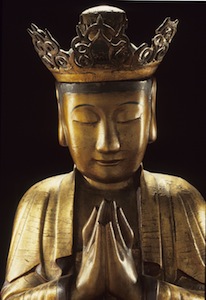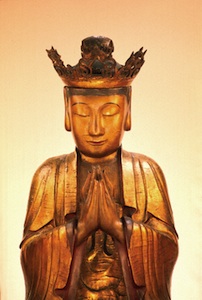Book
| Site: | Summit University Online |
| Course: | Moodle Sandbox |
| Book: | Book |
| Printed by: | Guest user |
| Date: | Thursday, November 21, 2024, 5:44 AM |
Description
This is an example of a book in Moodle. Like pages, books will contain a combination of text, links, images and multimedia clips, such as the example below.
1. Introduction
The following text in this online book on the life of Gautama Buddha was taken from the book The Masters and Their Retreats by Mark L. Prophet and Elizabeth Clare Prophet. It is interspersed with clips from the movie The Little Buddha, which tells the story of Prince Siddhartha on his path to enlightenment.

Copyright © Summit Publications, Inc. All rights reserved.
2. Who Is Gautama Buddha?
Gautama attained the enlightenment of the Buddha in his final incarnation as Siddhartha Gautama. He was born in northern India, about 563 BC, the son of King Suddhodana and Queen Mahamaya, rulers of the Sakya kingdom, and thus a member of the Kshatriya (warrior or ruling) caste.

Copyright © Summit Publications, Inc. All rights reserved.
3. Gautama's Birth and Prophesy
On the fifth day following his birth, 108 Brahmins were invited to a name–giving ceremony at the palace. The king summoned eight of the most learned from among these to 'read' the child's destiny by interpreting his bodily marks and physical characteristics.
Seven agreed that if he remained at home, he would become a universal king, unifying India; but if he left, he would become a Buddha and remove the veil of ignorance from the world. Kondañña, the eighth and youngest of the group, declared he would definitely become a Buddha, renouncing the world after seeing four signs—an old man, a diseased man, a dead man and a holy man. The child was named Siddhartha, or "One Whose Aim Is Fulfilled." Seven days after his birth, his mother passed on and he was raised by her sister Mahaprajapati, who later became one of his first female disciples.
Copyright © Summit Publications, Inc. All rights reserved.
4. A Turning Point
The king, concerned about the possibility of losing his heir, took every precaution to shelter his son from pain and suffering, surrounding him with every conceivable luxury, including three palaces and forty thousand dancing girls. At sixteen, after proving his skill in a contest of arms, Prince Siddhartha married his beautiful cousin Yasodhara. He soon grew pensive and preoccupied, but the turning point of his life did not occur until the age of twenty-nine, when he set out on four journeys, which presented in turn the four passing sights.
First, he encountered a very old man, gray and decrepit, leaning on a staff; second, a pitiful one racked with disease, lying in the road; third, a corpse; and fourth, a yellow-robed monk with shaved head and a begging bowl. Much moved with compassion by the first three sights, he realized that life was subject to old age, disease and death. The fourth sight signified to him the possibility of overcoming these conditions and inspired him to leave the world he knew in order to find a solution for suffering.
Copyright © Summit Publications, Inc. All rights reserved.
5. A Wandering Monk
On his way back to the palace, he received news of the birth of his son. That night he ordered his charioteer to saddle his favorite horse, Kanthaka. He rode all night and at dawn assumed the guise of an ascetic, exchanging clothes with his charioteer, whom he sent back to his father's palace.
Thus, Gautama began the life of a wandering monk. Immediately he went in search of the most learned teachers of the day to instruct him in truth, quickly mastering all they taught. Unsatisfied and restless, he determined to find a permanent truth, impervious to the illusions of the world.
Traveling through the Magadha country, he was noticed for his handsome countenance and noble stature. He arrived at a village called Senanigama, near Uruvela, where he was joined by a group of five ascetics, among whom was Kondañña, the Brahmin who had foretold his Buddhahood.
Here, for almost six years, Gautama practiced severe austerities. Finally realizing the futility of asceticism, Gautama abandoned his austerities to seek his own path of enlightenment—whereupon his companions rejected and deserted him.
Copyright © Summit Publications, Inc. All rights reserved.
6. Temptation and Enlightenment
One day Sujata, a villager’s daughter, fed him a rich rice milk—a "meal so wondrous...that our Lord felt strength and life return as though the nights of watching and the days of fast had passed in dream." (Arnold 1930, 96) And then he set out alone for the Bo tree, where he vowed to remain until fully illumined. At that point, Mara, the Evil One, attempted to prevent his enlightenment and confronted him with temptations much in the same manner that Satan tested Jesus during his fasting in the wilderness.
Unmoved, he sat under the Bo tree while Mara continued her attack—first in the form of desire, parading voluptuous goddesses and dancing girls before him, then in the guise of death, assailing him with hurricanes, torrential rains, flaming rocks, boiling mud, fierce soldiers and beasts—and finally darkness. Yet still, Gautama remained unmoved.
As a last resort, the temptress challenged his right to be doing what he was doing. Siddhartha then tapped the earth,* and the earth thundered her answer: "I bear you witness!" All the hosts of the Lord and the elemental beings responded and acclaimed his right to pursue the enlightenment of the Buddha—whereupon Mara fled.
Having defeated Mara, Gautama spent the rest of the night in deep meditation under the tree, realizing the Four Noble Truths. Thus, he attained Enlightenment, or the Awakening, during the night of the full-moon day of the month of May, about the year 528 BC. His being was transformed, and he became the Buddha.
Note
*with the "earth-touching mudra"—left hand upturned in lap, right hand pointed downward, touching the earth
Reference
Arnold, Edwin. 1930. The Light of Asia. London: Kegan Paul, Trench, Trubner & Co.
Copyright © Summit Publications, Inc. All rights reserved.
7. The Teachings of the Buddha
For a total of forty–nine days he was deep in rapture, after which he again turned his attention to the world. He found Mara waiting for him with one last temptation: "How can your experience be translated into words? Return to nirvana. Do not try to deliver your message to the world, for no one will comprehend it. Remain in bliss!" But Buddha replied: "There will be some who will understand," and Mara vanished from his life forever.

In his first sermon he revealed the key discovery of his quest: the Four Noble Truths, the Eightfold Path and the Middle Way. For forty–five years, Gautama walked the dusty roads of India, preaching the Dharma (universal Doctrine), which led to the foundation of Buddhism. He established the Sangha (community) that soon numbered over twelve hundred devotees. When the people questioned him as to his identity, he answered, "I am awake"—hence, the Buddha, meaning "Enlightened One" or "Awakened One."
He passed during the full moon of May, about 483 BC, after advising his chief disciple, Ananda, that the Dharma—the Truth—must be his master and reminding the monks of the transiency of all conditioned things.
Gautama Buddha today holds the office of Lord of the World (referred to as "God of the Earth" in Revelation 11:4). At inner levels, he sustains the threefold flame of life, the divine spark, for all children of God on earth. (Prophet and Prophet 2003, 111-114)